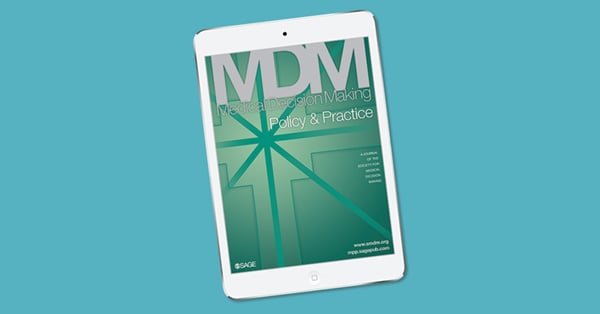Medical Decision Making
@MedDecMak
Medical Decision Making is published 8x per year - To improve public health and clinical care, MDM offers rigorous, systematic approaches to decision making.
Patient preferences of the general public can be a proxy for “at risk” patients in a disease prevention context when ranks but not weights are of interest. #PREFERLegacy bit.ly/3SSrXvw

What are the costs and resource utilization associated with 3 approaches recommended by the American Academy of Pediatrics to identify early onset sepsis in infants >=35 wks gestational age? @guanzgrace @joshi_ns @RebeccaDangMD @SalomonJA @dkowens bit.ly/3OBv9sE

Smoking history is a significant risk factor for #LungCancer, but what about never-smokers? This new study by @georgiabblack & colleagues sheds light on how clinicians make diagnostic decisions for this patient group @lungsforliving @CallisterMat @QuaifeS bit.ly/3UxZSdS

Conditional question wording can produce overestimates of the relationship between perceived risk and intended prevention behavior. Cause for concern? @jstrueder97 @jane_emiller @pwind44 bit.ly/48a9COA

Key predictors of COVID-19 outbreaks included county-level measures of COVID-19, facility population, and the test positivity rate in a facility. bit.ly/3UvGq1p

What happens when people face a new risk? This paper tracks how risk perceptions of COVID-19 changed over the first 18 months of the pandemic. @ksepucha @mghsdm @vavrek @dgsomucla @aaronrudkin @ucla @mgh bit.ly/3HPMKcC

SMDM announces GRANT (Grant Review And Networking for Trainees), a new quarterly program for members only. Learn more here: buff.ly/48dTRXd
Significant differences in attribute importance were found when comparing DCE and SW. This may indicate that DCEs are more suitable as they force respondents to trade-off attributes which reflect real-world valuations. bit.ly/3uuwURJ

Context matters. Stakeholders consider differences in patient casemix, quality of baseline care and research context to inform elicited adjustment of published interventions effects in a local setting @jonkarnon @vaughn_eaton @SouthernAdlLHN @FlindersHMRI bit.ly/3wjYEZC

Internationally, many studies have estimated quality of life for cardiovascular diseases since 2013. Unexplained heterogeneity raised methodological questions about choosing values for a UK context. @HealthEcon_MCR #healtheconomics #qualityoflife bit.ly/3uyiG23
A new study develops and applies a framework for reducing bias in county-level estimates from the COVID-19 Trends and Impact Survey. @MarissaReitsma, @sherrirose, @capnrefsmmat, @SalomonJA @sc_cosmo, @PrevPolicy, @HPDSLab, @StanfordHP bit.ly/3voGS7i

Both the SARIMA and ETS models provided similar forecasts, but measures of fit and expert knowledge gave a slight preference to the model in predicting the flow of blood donations in Zimbabwe. bit.ly/499YAdG
Knowledge matters! Research reveals that only a small percentage of adults accurately assess the chances of surviving #CPR. Better understanding survival rates can influence end-of-life preferences. Let's promote informed decision-making. #InformedChoices bit.ly/4aMpPft

Invite your peers to join us for our free webinar, "Introduction to MDM." What a great opportunity to get a taste for the field of medical decision making. 28 February 2024. Learn more here: netforum.avectra.com/eweb/DynamicPa…
Including mortality statistics in communications decreased the perceived effectiveness of cancer screening and screening intentions. #fiveyearsurvivalrates #cancerscreening #perceivedeffectivenessofscreening bit.ly/3NM8jyf

Key digital health stakeholders seem unclear on how to value provider-facing technologies. This value framework is the first attempt to contribute towards that goal. @LSE_MTRG #digitalhealth #HTA #assessment bit.ly/48j1AnK

In 2018, @AmerAcadPeds recommended three screening approaches to identify early onset sepsis in infants born at >= 35 weeks. ➡️ What are the costs associated with each approach? ➡️ New paper in @MedDecMak Policy & Practice doi.org/10.1177/238146… 🧵
Patients and care partners used multifaceted reasoning in their assessment of diagnostic accuracy, including their perception of the process and whether the diagnosis matched other factual information they had. #mdm bit.ly/41KaCaI
Patients with a strong desire for surgery were less likely to choose the use of a decision aid for orthopedic care of hip and knee osteoarthritis. @JesseJansen_ @jeroenbossen #caphri #maastrichtuniversity #decisionmaking bit.ly/3vwNa4A
Study finds integrating diabetes care in Nepal’s primary health system can reduce expenses and enhance quality. @dahal_pada #DiabetesNepal #HealthcareCosts #DiabetesCost bit.ly/48Jy8qN
